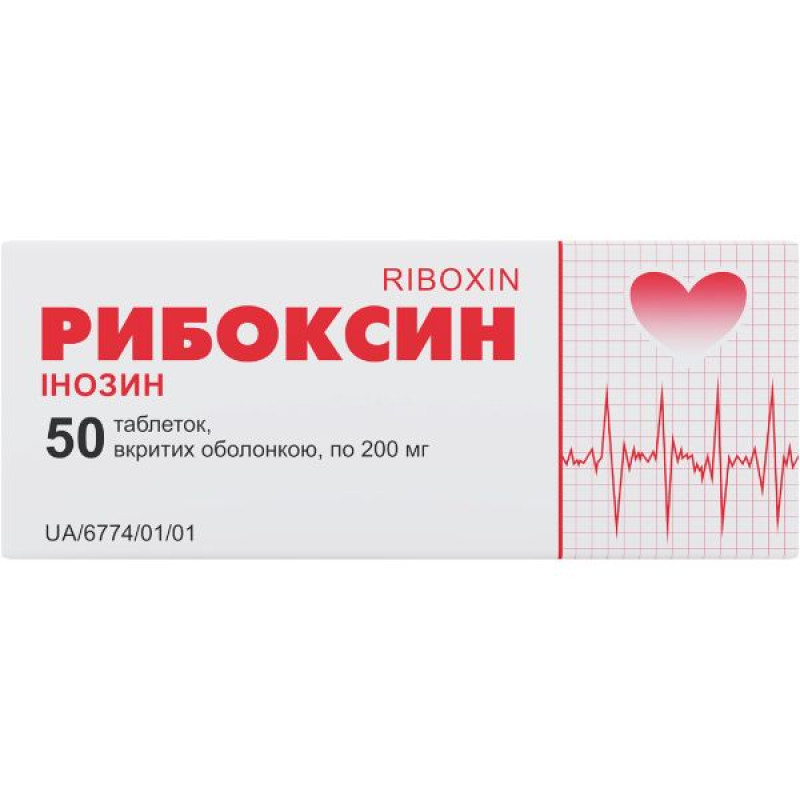Riboxin film-coated tablets 200 mg blister No. 50

Translation of the instructions can be
RIBOXIN film-coated tablets 200 mgInstruction
For medical use of the medicinal product
Riboxin
(Riboxin)
Composition:
Active ingredient: riboxin (inosine);
1 tablet contains riboxin (inosine) - 200 mg;
Excipients: potato starch, microcrystalline cellulose, hypromellose (hydroxypropylmethylcellulose), croscarmellose sodium, povidone 25, magnesium stearate, talc, titanium dioxide (E 171), polyethylene glycol 6000 (macrogol 6000), polysorbate 80, quinoline yellow (E 104).
Dosage form.
The pills are coated.
Main physicochemical properties: round, film-coated tablets, light yellow to yellow in color, with convex upper and lower surfaces. When broken, when viewed under a magnifying glass, a core surrounded by a single solid layer is visible.
Pharmacotherapeutic group.
Cardiological drugs. inosine.
PBX code S01E B.
Pharmacological properties.
Pharmacodynamics.
Riboxin is an anabolic drug that provides antihypoxic and anabolism effects.
It is a precursor of ATP, takes a direct part in glucose metabolism and promotes the activation of metabolism in conditions of hypoxia and in the absence of ATP. The drug activates the metabolism of pyruvic acid to ensure the normal process of tissue respiration, and also promotes the activation of xanthine dehydrogenase. Riboxin has a positive effect on the metabolism in the myocardium, in particular, increases the energy balance of cells, stimulates the synthesis of nucleotides, increases the activity of a number of enzymes of the Krebs cycle. The drug normalizes the contractile activity of the myocardium in diastole due to the ability to bind calcium ions that have penetrated the cells during their excitation, activates tissue regeneration (especially the myocardium and the mucous membrane of the digestive canal).
Pharmacokinetics.
Well absorbed in the gastrointestinal tract. Metabolized in the liver with the formation of glucuronic acid and its subsequent oxidation. In small quantities excreted by the kidneys.
Clinical characteristics.
Indication.
Comprehensive treatment of ischemic heart disease (condition after myocardial infarction, angina pectoris), heart rhythm disturbances, intoxication with cardiac glycoside drugs, treatment of cardiomyopathies of various genesis, myocardial dystrophy (against heavy physical exertion, infectious and endocrine genesis), myocarditis; liver diseases (hepatitis, cirrhosis, fatty liver dystrophy); urokoporphyria.
Contraindication.
Hypersensitivity to the active substance or to other components of the drug. gout, hyperuricemia, renal failure.
Interaction with other drugs and other types of interactions.
When used with cardiac glycosides, inosine prevents the development of arrhythmias and enhances the inotropic effect.
Inosine can be used simultaneously with anabolic agents (potassium orotate, methandrostenolone), nitroglycerin, nifedipine, furosemide, spironolactone.
When inosine is used simultaneously with beta-blockers, the effectiveness of inosine is not reduced.
Riboxin increases the duration of action of heparin.
Forms a precipitate with tannin.
With hypouricemic agents, it weakens the effects of hypouricemic agents.
Application features.
If itching and skin hyperemia occur, treatment with the drug should be discontinued.
During treatment, the level of urea concentration in the blood and urine should be regularly monitored.
In case of renal failure, the drug should only be prescribed if, in the opinion of the doctor, the expected effect outweighs the possible risk of use.
Use during pregnancy or breastfeeding.
Due to insufficient data on the safety of the drug for this group of patients, Riboxin should not be used during pregnancy or breastfeeding.
The ability to influence the reaction speed when driving vehicles or other mechanisms.
The drug does not have a negative effect on the ability to drive a car and work with complex mechanisms.
Method of administration and doses.
Tablets should be taken orally, before meals, without chewing, with sufficient water. The daily dose is determined individually and is for adults 600-2400 mg (3-12 tablets). For adults in the first days of treatment, the daily dose is 600-800 mg (1 tablet 3-4 times a day). If the drug is well tolerated, the dose should be increased within 2-3 days from 1200 mg (2 tablets 3 times a day) to 2400 mg.
The duration of the treatment course is from 4 weeks to 1.5-3 months.
For uroproporphyria, the daily dose is 800 mg (1 tablet 4 times a day), the duration of the treatment course is 1-3 months.
Children.
Should not be used in children due to lack of safety data.
Overdose.
Symptoms: increased side effects, allergic reactions, nausea, diarrhea, abdominal pain.
Treatment: discontinuation of the drug and symptomatic therapy.
Adverse reactions.
Cardiac disorders: tachycardia, hypotension, which may be accompanied by headache, shortness of breath, dizziness, nausea, vomiting, sweating.
Immune system, skin and subcutaneous tissue disorders: allergic/anaphylactic reactions including rash, itching, redness of the skin, urticaria, anaphylactic shock.
From the side of metabolism: hyperuricemia, increased uric acid levels in the blood, with prolonged treatment - exacerbation of gout.
Others: general weakness.
Expiration date.
3 years.
Store in original packaging at a temperature not exceeding 25 0C.
Keep out of reach of children.
Packaging.
10 tablets in blisters; 10 tablets in a blister; 5 blisters in a cardboard pack; 10 tablets in a blister; 90 blisters in a cardboard box.
Vacation category.
According to the recipe.
Producer.
Ciao "technologist".
Location of production and its address of place of business.
Ukraine, 20300, Cherkasy region, Uman city, Stara Prorizna street, building 8.
There are no reviews for this product.
There are no reviews for this product, be the first to leave your review.
No questions about this product, be the first and ask your question.

